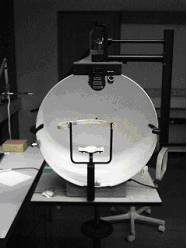Perimetry
| Perimetry | |
|---|---|
| ICD-9-CM | 95.05 |
| MeSH | D010499 |
Perimetry or campimetry is one way to systematically test the visual field.[1] It is the systematic measurement of differential light sensitivity in the visual field by the detection of the presence of test targets on a defined background. Perimetry more carefully maps and quantifies the visual field, especially at the extreme periphery of the visual field. The name comes from the method of testing the perimeter of the visual field.
Visual field testing can be performed clinically by keeping the subject's gaze fixed while presenting objects at various places within their visual field. Simple manual equipment can be used such as in the tangent screen test or the Amsler grid. When dedicated machinery is used it is called a perimeter.
Uses
Automated perimeters are used widely, and applications include: diagnosing disease, job selection, visual competence assessment, school or community screenings, military selection, and disability classifications.[2]
Types of perimetry

Tangent screen
The simplest form of perimetry uses a white tangent screen.[3] Vision is tested by presenting different sized pins attached to a black wand, which may be moved, against a black background.[3] This test stimulus (pins) may be white or colored.[3]
Goldmann perimeter
The Goldmann perimeter is a hollow white spherical bowl positioned a set distance in front of the patient.[3] An examiner presents a test light of variable size and intensity. The light may move towards the center from the perimeter (kinetic perimetry), or it may remain in one location (static perimetry). The Goldmann method is able to test the entire range of peripheral vision, and has been used for years to follow vision changes in glaucoma patients.[3] However, now automated perimetry is more commonly used.
Automated perimetry
Automated perimetry uses a mobile stimulus moved by an perimetry machine. The patient indicates whether they see the light by pushing a button. The use of a white background and lights of incremental brightness is called "white-on-white" perimetry. This type of perimetry is the most commonly used in clinical practice, and in research trials where loss of visual field must be measured.[4] However, the sensitivity of white-on-white perimetry is low, and the variability is relatively high; as many as 25-50 percent of the photoreceptive retinal ganglion cells may be lost before changes in visual field acuity are detected.[4]
Microperimeter
The microperimeter assesses the macular function in a computerised way. A 2012 observational study by Pacella et al.[5][non-primary source needed] found a significant improvement in both visual acuity and fixation treating age-related macular degeneration or macular myopic degeneration with biofeedback treatment through MP-1 microperimeter.
Methods of stimulus presentation
Static perimetry
Static perimetry tests different locations throughout the field one at a time.[3] First, a dim light is presented at a particular location. If the patient does not see the light, it is made gradually brighter until it is seen.[3] The minimum brightness required for the detection of a light stimulus is called the "threshold" sensitivity level of that location.[3] This procedure is then repeated at several other locations, until the entire visual field is tested.[3]
Threshold static perimetry is generally done using automated equipment. It is used for rapid screening and follow up of diseases involving deficits such as scotomas, loss of peripheral vision and more subtle vision loss. Perimetry testing is important in the screening, diagnosing, and monitoring of various eye, retinal, optic nerve and brain disorders.
Kinetic perimetry
Kinetic perimetry uses a mobile stimulus moved by an examiner (perimetrist) such as in Goldmann kinetic perimetry.[6] First, a single test light of constant size and brightness is used. The test light is moved towards the center of vision from the periphery until it is first detected by the patient. This repeated by approaching the center of vision from different directions. Repeating this enough will establish a boundary of vision for that target. The procedure is repeated using different test lights that are larger or brighter than the original test light.
In this way, kinetic perimetry is useful for mapping visual field sensitivity boundaries. It may be a good alternative for patients that have difficulty with automated perimetry, either due to difficulty maintaining constant gaze, or due to congnitive impairment.[7]
See also
- Binasal hemianopsia
- Bitemporal hemianopsia
- Blind spot
- Preferential hyperacuity perimetry
- Tunnel vision
References
- ^ "Visual Field". NIH, US National Library of Medicine. Medline Plus. Retrieved 28 November 2012.
- ^ "1990 Perimetry Standards". First Codicil. Imaging and Perimetry Society. Retrieved 28 November 2012.
- ^ a b c d e f g h i Cunningham, Emmett T. (2011). "Chapter 2: Ophthalmologic Evaluation - Specialized Ophthalmologic Examinations". Vaughan & Asbury's general ophthalmology (18th ed.). New York: McGraw-Hill Medical. ISBN 978-0071634205.
{{cite book}}: Unknown parameter|coauthor=ignored (|author=suggested) (help) - ^ a b McKendrick, Allison M (2005). "Recent developments in perimetry: test stimuli and procedures". Clinical and Experimental Optometry. 88 (2): 73–80. doi:10.1111/j.1444-0938.2005.tb06671.x. PMID 15807638. Retrieved 29 November 2012.
{{cite journal}}: Unknown parameter|month=ignored (help) - ^ Pacella, E; Pacella, F; Mazzeo; Turchetti, P; Carlesimo, SC; Cerutti, F; Lenzi, T; De Paolis, G; Giorgi, D (November 2012). "Effectiveness of vision rehabilitation treatment through MP-1 microperimeter in patients with visual loss due to macular disease". Clin Ter: 163(6):e423–8. PMID 23306757.
{{cite journal}}: Unknown parameter|firs3t=ignored (help) - ^ "What is Perimetry?". Imaging and Perimetry Society. Retrieved 28 November 2012.
- ^ Ing, Edsel. "Neuro-Ophthalmic Examination". Web MD, LLC. Medscape. Retrieved 29 November 2012.
Further reading
- Spector, Robert H. 1990. Visual Fields. Clinical Methods The History Physical and Laboratory Examinations 3rd ed, Walker HK, Hall WD, Hurst JW editors. Butterworth. VIII:116;565-572 NIH Books
